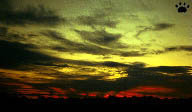
Sunset, Ussuriland, Russia
Weather
The sky overhead is one of the most beautiful and dynamic things
we see in our life, yet most people pay little attention to it. Even the most
picturesque stuff like rainbows, sunsets and thunderstorms,
which is shown to us regularly and free of charge, does not get much attention.
|
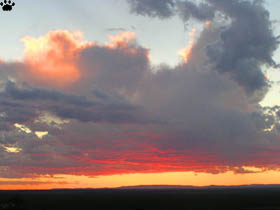 |
 |
| Sunset at Wheeler Peak, New Mexico. |
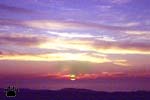 Green flash,
Green flash,
Farallon Islands, USA |
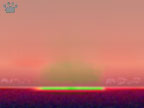 Green flash, Paramushir,
Green flash, Paramushir,
Kuril Islands, Russia |
The famous Green Flash is not as rare
as generally believed. If you often watch sunsets at a seashore, sooner or later
you'll see it, especially if you watch from seaside mountains. California and
Hawaii are both good places to look for Green Flash or for Novaya Zemlya effect,
when you can see the sun for few seconds after the actual sunset. |
 |
 |
 |
 |
Sunset near Davidson
Seamount, off California.
The main difficulty in observing Green Flash is that it is very brief.
Only one of the above pictures shows it clearly, although they were taken with
1-minute intervals. |
| The Pacific Rim is probably the
best place to watch sunsets. This one was really a good luck, because there are
only 20-30 sunny days per year at Commander Islands.
These islands are so well hidden in sea fog, that even the Aleuts had not found
them until Bering's expedition discovered them occasionally in the 18th century. |

Sunset at fur seal rookery,
Commander Islands, Russia |
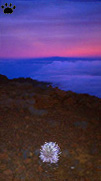
Silversword plant,
Haleakala, Hawaii |
Summits of Hawaiian volcanoes provide a good opportunity
to watch bright-colored sunsets while staying above the clouds. Although there
is some very unusual flora and fauna on these mountain tops, they look so desolated
that it feels like watching the sunset from outer space. As Hawaii are far from
any continent, there is almost no dust in the air, and astronomic visibility is
unique - no wonder the famous observatory was built on Mauna Kea. But tropical
sunsets are very brief - you have to visit high latitudes to get an opportunity
to enjoy sunsets for hours (or, if you get very close to a pole, for days). |
| Beyond the Arctic Circle, summer "nights"
are the most beautiful time. Sunset-like colors set the sky aflame, everything
is quiet, and mosquitos are mostly sleepy. On Arctic islands, there are no sunsets
at summer, but August to October is practically one long sunset. |

Sunset, Teriberka
fjord, Russia |
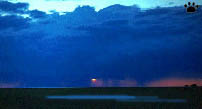
Monocell thunderstorm,
Khanka Lake, Ussuriland, Russia |
Even during the monsoon season,
when it can rain for weeks, a change from rain to a thunderstorm can result in
beautiful sunset. Traveling in China or Russian
Far East, you are sometimes awarded by such a sight after many days of awful
weather. |
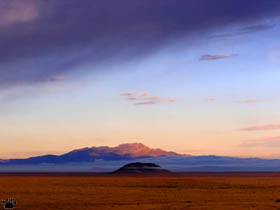 |
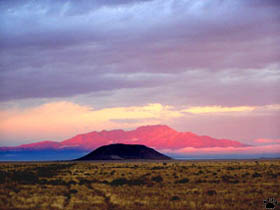 |
| Morning at Sevilleta National Wildlife
Refuge , New Mexico. |
Deserts normally have clear, but dull sunsets and sunrises. This
one (right) was the only exception in more than six months I have spent in the
deserts of the Middle East. I watched in from a yacht in the Gulf of Akaba.
 |  |
| Sunsets, Arizona |
|
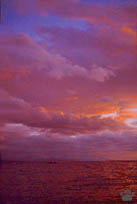
|
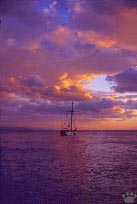
Winter sunset, Red Sea |
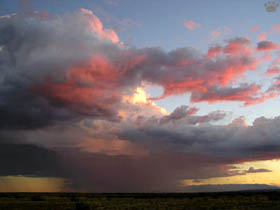 |
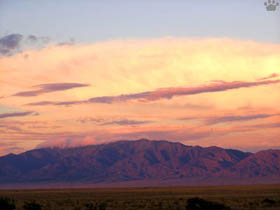 |
| Monsoon season sunset at Sevilleta
National Wildlife Refuge , New Mexico. |

Spring sunset, Tucson, USA |

Spring sunset, Tucson, USA |
Only when rain clouds make it to the deserts,
they bring bright colors to the desert sky. Spring and summer sunsets can be very
beautiful in Sonora and other North American
deserts. |
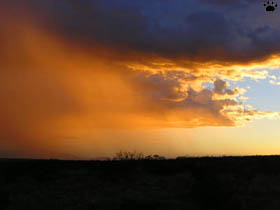 |
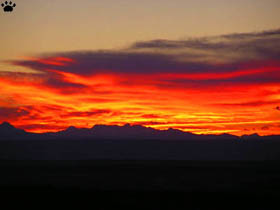 |
| Sunsets in Chihuahua (left) and Great
Basin Deserts, USA. |
| In high mountains of Yunnan and
Sichuan, monsoon rains often fall nonstop for up to five months every year. As
rivers flood narrow canyons, the secondary evaporation from mountain slopes forms
spectacular clouds which gave one area in Yunnan its name Yunlong
- "The country of dragons in the clouds" |
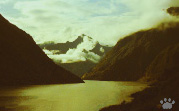
Monsoon clouds, Yunnan, China |
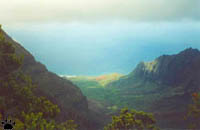 View from Kokee Plateau, Kauai.
View from Kokee Plateau, Kauai. |
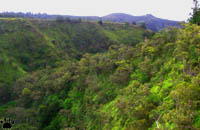 Alakai Swamp, Kauai.
Alakai Swamp, Kauai. |
The wettest place on Earth, however,
is not in Asia or South America, but in the mountains of Kauai - one of Hawaiian
Islands. |
| High mountains usually have interesting
and beautiful weather, even broad plateaus with plain-like landscape. In the vast
grasslands of Tibet, violent snowstorms can happen at any time of the year, but
thunderstorms and hailstorms are more common during monsoon. This hailstorm killed
so many hares and birds, that local people stored enough meat for many days. |
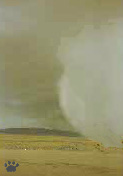 Hailstorm, Changtang, Tibet
Hailstorm, Changtang, Tibet |

Summer monsoon, Vahan Valley, Afghanistan |
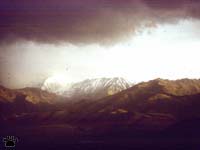
Summer monsoon, Pamir, Tajikistan |
Some summers, the Indian monsoon
gets to Pamir, bringing rain and snow to the
high desert. |
| Most years, storms are rare in summer on Pamir Plateau,
but they are always spectacular. This thunderstorm flooded our camp,
although it was on a slope, not on a valley floor. Even when the monsoon spills
to Pamir over Hindukush once in a few years, it only reaches its southeastern
and southwestern corners. You have to go to the Eastern Himalayas, to Bhutan or
Northeastern India, to see the full splendor of the monsoon, when up to 15 m (50')
of rain may fall in one month. |
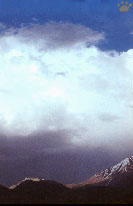
Summer thunderstorm,
Northern Pamir, Tajikistan |
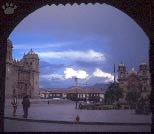 Central Square, Cuzco, Peru
Central Square, Cuzco, Peru |
Cuzco, the most beautiful city in the Americas, owes
much of its beauty to its weather: the ancient capital of Inca Empire is one of
the highest cities in the world. During a day, the weather can change many times,
and the light is so interesting that Cuzco is a photographer's paradise. |
| Parts of the Andes are so dry that no clouds form above
them for years. In such areas, you can see typical "desert-style" sunsets
at 6000 meters (20,000 feet) above the sea level. Some of these valleys are the
driest places on Earth - it has never been raining here since at least the 15th
century. Some Chilean mountains are the only places on our planet with no water
erosion. Lack of surface runoff made possible the preservation of ancient landforms
and famous Nazca Lines. |

Ancient mummy in a cave,
Sechin, Peru. |
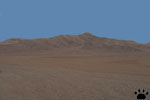 Atacama Desert, Chile.
Atacama Desert, Chile. |
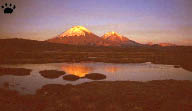
Sunset, Lauca National Park, Chile |
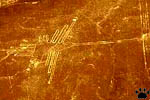 Nazca Plateau, Peru.
Nazca Plateau, Peru. |
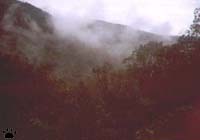 Cloud forest below Fitzcarraldo Pass,
Cloud forest below Fitzcarraldo Pass,
Manu National Park, Peru. |
Not far from these "absolute deserts", you
can see cloud forests where it rains daily for centuries. In some canyons, the
afternoon air is so filled with moisture that you can sometimes provoke the rain
by shouting loud, or by firing a gun. But these rains are never as intense as
monsoon rains of Asia. Only in the outer parts of Great Neotropic Rainforest,
you can see well-developed monsoon season with its violent thunderstorms and hurricanes. |
| During the rainy months, tornadoes can be occasionally
seen in La Plata, Orinoco and Magdalena river basins. |
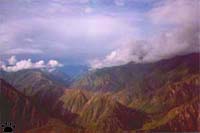 Monsoon clouds, Nevado Del Ruis, Colombia.
Monsoon clouds, Nevado Del Ruis, Colombia. |
 Developing F1 tornado, near Medellin, Colombia.
Developing F1 tornado, near Medellin, Colombia. |
| In El Ninyo years, spectacular storms can be seen in
many parts of the Pacific. In 1998, whole stretches of Californian coast were
washed away by high surf. It was a horror year for beachfront property owners,
but a Nature's gift for surfers and photographers. |
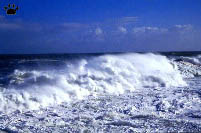 Winter storm, Point Arena, California
Winter storm, Point Arena, California |
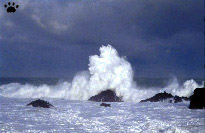
The strongest storm of 1998,
Lost Coast, California |
These storms severely damaged some ecosystems in tidal
zone, and killed hundreds of pups in some colonies of elephant and harbor seals.
In normal years, storms are seldom so severe in California, but even worse on
the eastern coast of Kamchatka and the Kuril Islands, especially in the Museum
of Natural Disasters area. |
| Inland seas have storms with smaller waves, but these
waves have more steep slopes, and navigation is often difficult because of winding
shoreline. In the Baltic Sea, dozens of shipwrecks occur every fall and winter,
when thunderstorms carry blizzards over labyrinths of reefs and islets in the
northern part and in sandy shallows in the south. These are, of course, only weak
remains of violent storms in the North Atlantic. |
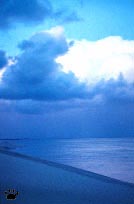 Snow thunderstorm,
Snow thunderstorm,
Kurshskaya Kosa, Russia |
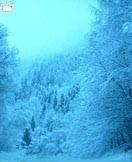
The Great Snowfall of 1987,
Kageti, Georgia |
The heaviest snowfall in modern
history occurred in 1987 on both slopes of Western Caucasus. In some valleys,
more than 33 meters (100') of snow packed the forest up to treetops. The Nordmann
firs on this picture are in fact 70 m (230') tall. Mega-avalanches destroyed hundreds
of villages, including some Svanetian towers
more than thousand years old. I took part in a mountaineering expedition that
winter, but we could hardly move in bottomless ocean of snow, and soon joined
a rescue team to help evacuate Georgian villagers. In normal
years, there is no more than 24 m (80') of snow in the mountains of Caucasus. |
| Tornadoes can be seen off Western Caucasus almost
annually. They form offshore in late August or early September. Most of them appear
at night and can only be seen with a good lightning. Once I wrote an article
about this and other interesting things for Storm
Track - a journal about to storm chasing in the USA and elsewhere, but mostly
in the "Tornado Alley" of the Great Plains
- by far the best place to look for tornadoes. |
 Small (F1) tornado
Small (F1) tornado
over Black Sea,
off Adler, Russia |
 Large (F3) tornado and
Large (F3) tornado and
lightning at night,
off Utrish, Russia |
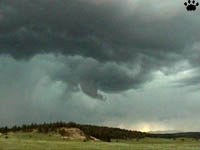
Funnel cloud, Florrissant Fossil Beds, Colorado |
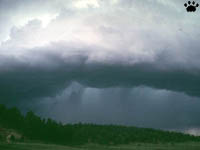
Supercell storm, Florrissant, Colorado |
The Tornado Alley has the most spectacular thunderstorms
in the world. The best time to see them is usually early May to late June. |
| These storms get particularly violent when a cold
front from the Rocky Mountains rolls east across the prairie and rams into the
moist air that spreads north from the Gulf of Mexico. |
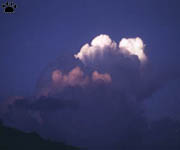
Cumulus cloud, Wind Cave, S. Dakota. |
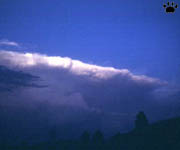
Anvil cloud, Wind Cave, S. Dakota. |

Small (F0) tornado,
Panoche, California. |

Supercell thunderstorm near Calgary, Canada. |
Thousands of people come to the Alley every spring
for tornado chasing. I've been there during May season twice, with no luck. But
I did see a rare winter tornado in California's Central Valley, and a splendid
supercell thunderstorm in Alberta, at the northern edge of the Alley, in July
99. |
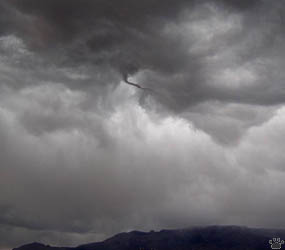 |
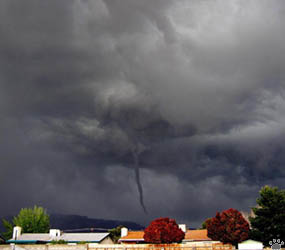 |
| Funnel cloud over Albuquerque, New
Mexico. |
| Storms usually start in southeastern parts of the
Alley in March, then gradually shift west and north, reaching Canada and Rocky
Mountains foothills by June. |
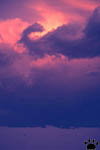
Storm, White Sands. |
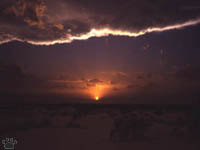
Stormy sunset, White Sands, New Mexico. |
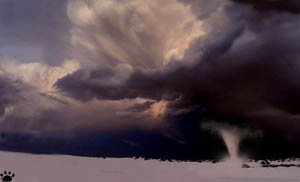
Tornado, White Sands Nat'l Monument. |
In May 2004, I was lucky to videotape this albino tornado
at White Sands, New Mexico, at sunset. It was short-lived (about 10 seconds),
probably F2, and very beautiful. The same supercell thunderstorm also produced
cherry-size hail, and some nice rainbows. Below is a 360 degree panorama of the
storm (composition of 20 videoframes). Larger photos |

Tornado, White Sands Nat'l Monument. |
| If you are an inexperienced tornado chaser,
it is always better to use a rental car. The risk of being hit by a tornado is
minimal, but large hail is always a possibility. It is often difficult to see
before it starts falling on you; the hailstones can be as big as apricots, and
sometimes as big as small melons. |

Hail, N. Dakota. |

Hail, Colorado. |
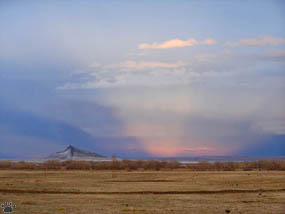
Crepuscular rays, near Pueblo, Colorado. |
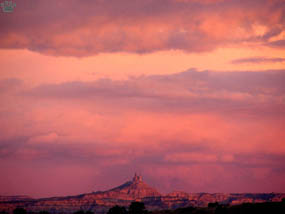
Sunset, Bisti - De-Na-Zin Wilderness, New Mexico. |
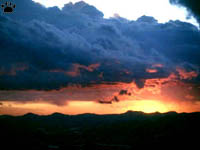
Sunset on Mount Evans, Colorado. |
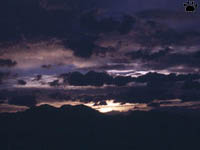
Windy night at Mount Evans. |
If tornado chasing sounds too risky for you, try
watching these storms from the safety of Mount Evans in Colorado - it overlooks
the Plains. |
| Mt. Evans is also a good place to see rare types of electric
discharges known as red elves. Unlike lightning, they occur above the clouds,
not below them. |

Thunderstorm in Chiapas, Mexico. |
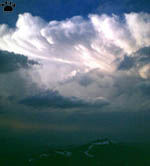
Mount Evans view. |
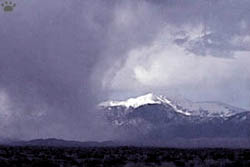
|
 |
| Snowstorm moving along Sangre de Cristo
Mountains, Colorado. |
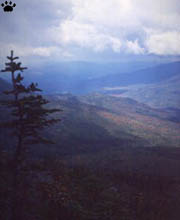
View from Mount Washington. |
Another North American mountain famous
for interesting weather is Mt. Washington in New Hempshire. The strongest winds
ever recorded were measured at its summit.

Cloudy day at Mt. Washington. |
| Northeastern North America is not only a region with
particularly unpleasant weather. It is also the most accessible place to see Northern
lights - thanks to the proximity of the Magnetic Pole, they can regularly be seen
further south here than in Alaska, Northern Europe, or Siberia. |
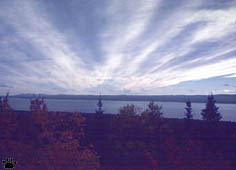
Cirrus clouds over Labrador Peninsula.
a |

Aurora,
Labrador. |

High-altitude clouds,
Great Slave Lake, NWT. |
The area south from Great Slave Lake is good for Northern
lights, and, in summer, for high-altitude clouds. They consist of hydrogen peroxide
or, according to another theory, of sulfuric acid, and can sometimes be seen in
the sky all night long (that is, 3-4 hours). |
Californian weather seems
dull in summer, but winter and spring are sometimes violent and unpredictable.
This snowstorm was associated with the strongest one of many unusually deep cold
fronts in "La Ninya" year of 1999. Below 1500 m it was a rainstorm with
some hail. Driving to the summit in our tiny Toyota, we just missed a chance to
become the first avalanche victims in the history of San Francisco Bay Area!

View of Golden Gate Bridge distorted by refraction. |
 Winter snowstorm,
Winter snowstorm,
Mt. Hamilton, California. |

View of coastal fog and Green Flash
from Cone Peak. |
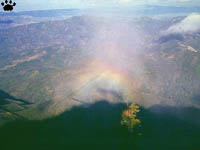
"Broken Effect",
Cone Peak, California. |
Cone Peak in Santa Lucia Mountains
is one of the best places in the
world to look for interesting things in the sky: fog and storm clouds,
green flash and Broken effect, beautiful sunrises and sunsets, weird halos and
winter rainbows. |
| Even with no storms around, the Pacific Rim is still the area
with the most beautiful weather on Earth. Ocean currents bring layers of fog to
the shores of Asia and America, cold waves from Siberia and Arctic Canada flood
intermontane valleys, dry hot air from Mongolia and Mojave rushes to the coasts
each summer - every day you can see something new in the sky. |
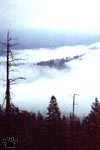
Fog, Olympic Peninsula,
Washington, USA |
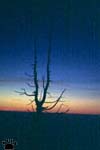
Sunset, Mount Adams,
Oregon, USA |
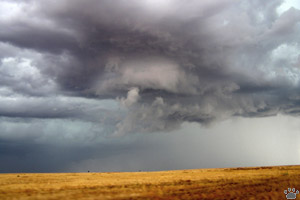
Supercell thunderstorm, Zombitsi National Park, Madagascar.
Part Two. Hurricanes
Home |

